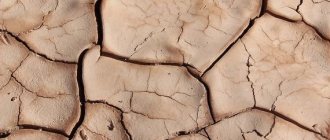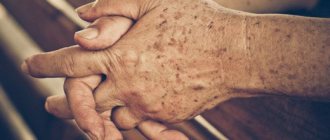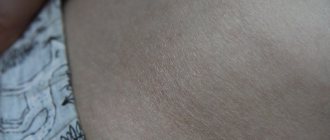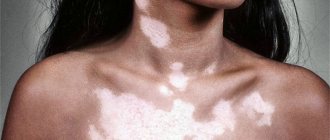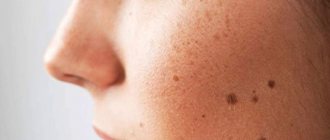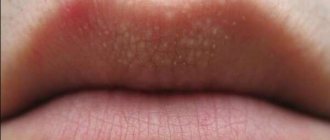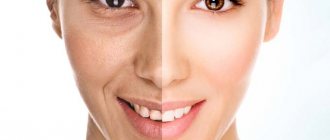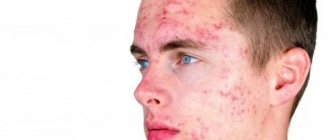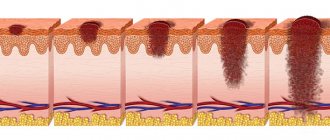Pink spot with white rim
The condition of the skin, like a mirror, reflects the general condition of the body.
Among the symptoms of many diseases there are all kinds of skin manifestations, and this allows you to notice the problem in time and cure it as quickly as possible. For example, if you have a spot on your skin with a red rim, then you must consult a dermatologist.
The fact is that this symptom is characteristic of a number of diseases that require different types of treatment, and the longer you delay a visit to the hospital, the more difficult it will be to eliminate the problem.
Possible reasons
A spot with a red rim that appears on the skin is a characteristic sign of disease, and in most cases, infection with some type of fungus is diagnosed.
Here are the most common causes of skin lesions in the form of spots with a pink or red edge:
- fungal;
- infectious and viral;
- allergic;
- endocrine and others.
It should be noted that the symptoms of the same disease may be stronger or weaker in different people. For example, psoriasis may begin as fairly pronounced spots with a clear border of a contrasting color, but it quickly acquires characteristic additional signs. The affected surface of the skin begins to peel off with mealy flakes, somewhat reminiscent of oatmeal.
Skin monitoring
If the reason for your visit to a dermatologist is a spot with a red rim that appears on the skin, you should carefully monitor the accompanying symptoms.
You may have noticed that new spots are appearing, the skin has begun to peel off, or existing marks are constantly enlarging, itching or changing color. What does the skin look like inside the spot, is there a depression or an inflamed, weeping surface there?
If a spot appears on the scalp, does the hair fall out? All these are important additions that will help make the correct diagnosis.
Fungal diseases
Fungal skin diseases are often called the general word “lichen,” but this is not entirely true.
For example, pityriasis rosea is an inflammatory disease presumably of viral origin, although the causative agent has not yet been identified, and its similarity with the same ringworm is very distant.
An inexperienced eye will not reveal any special differences, but fungal diseases are characterized by a clear boundary - a spot on the skin with a red rim, and the shape of the formations is round or oval.
Multicolored, ringworm, or lichen planus - all these diseases are caused by fungi. In most cases, doctors prescribe complex treatment that combines external agents in the form of ointments or sprays and systemic antifungal tablets. “Lamisil”, “Clotrimazole”, “Fluconazole” and similar products.
Why should you go to a dermatologist?
Visual self-diagnosis is quite unreliable; you can mislead yourself and begin long-term and hopeless treatment of symptoms. Sometimes you can accidentally guess, and then the treatment will work, but is it worth making a lottery out of your own health?
To diagnose fungal diseases, for example, a comprehensive examination of scrapings is carried out under a microscope, and the material is also checked in the rays of a fluorescent lamp with a Wood filter.
Yes, at first glance, a white spot with a red rim on the skin resembles some types of lichen; sometimes young psoriatic plaques look like this. But the final diagnosis and selection of medications must be made by a dermatologist.
Traditional medicine recipes
If you have a round spot on your skin with a red rim, in this case traditional medicine recommends using natural remedies. For ringworm, the spots are generously moistened with vodka infused with crushed garlic. In various combinations, alcohol and garlic are used to treat any skin manifestations.
Natural birch tar is included in many medicines. You can lubricate lichen plaques either with pure tar or in a mixture with egg white. The same remedy is used for weeping eczema, which is sometimes mistaken for lichen.
But nicotine tars from a smoker’s pipe, which are also called medicinal, can in fact only cause severe allergic complications. Resin received its reputation as a medicinal product solely because of its external resemblance to tar.
Causes
If a spot appears on the skin with a red rim, you need to visit a dermatologist for diagnosis.
Skin rashes can be caused by:
- fungi;
- viral microorganisms;
- autoimmune diseases;
- lichen;
- allergy;
- pathogenic bacteria.
Only after the examination does the doctor select drug therapy.
Fungal infection
A round spot on the skin with a red rim may indicate a fungal infection. This is a disease that can be contracted in public places or through contact with an infected person.
Infection also occurs due to chronic diseases of internal organs, uncontrolled use of antibacterial drugs, and disturbances in the functioning of the immune system.
The danger of a fungal infection is that the rash quickly spreads over the surface of the epidermis, infecting healthy areas. The most common cause of the rash is ringworm or versicolor.
Pathogenic bacteria can provoke a fungal infection. The most common disease is erythrasma, or pseudomycosis.
This disease has periods of remission and relapse. Most often it occurs in people with increased body weight, and in those who do not follow the rules of personal hygiene.
During the period of relapse, the white spot has a red and clear edge. Most often it is localized in the navel, under the armpit, in the groin or under the mammary glands.
! Fungal infections are treated with systemic antifungal drugs.
Viral diseases
Viral diseases that manifest as rashes are associated with dysfunction of the immune system. Each type of disease has its own characteristic features.
Herpes zoster is of viral origin. The patient develops plaques with a clear outline, which in appearance resemble bubbles with liquid inside.
The spreader of the disease is the herpes virus type 3, which manifests itself most actively in people with reduced immunity and those who have had colds. Most often, the pathology is observed on the patient’s face. When you touch the rash, painful sensations appear. The mark itself does not itch.
Pityriasis rosea is caused by a virus. It stays in the body for a long time and manifests itself under favorable conditions. The initial stage is characterized by the appearance of a large pink plaque. As the virus spreads through the body, many small rashes form over time. Initially they are pink or red in color, and after 14 days they turn yellow. They have a convex shape.
Main locations: back, chest and shoulders. If you suspect the presence of pityriasis rosea, it is recommended that you familiarize yourself with the photo, which will help determine whether infection has occurred.
! After 2 weeks, the pathology disappears on its own without treatment.
Lichen planus is a chronic inflammatory disease. The color of the plaques is red or burgundy. The spot itches and flakes off inside. The disease is diagnosed in children and adults.
Allergy
The rash causes itching and burning. As the disease progresses, the spots fill with liquid and look like small blisters.
The reasons for their appearance are associated with the entry of an allergen into the body, which provokes increased production of histamine by the immune system.
Treatment is prescribed by an allergist after conducting special tests with explanations of what type of allergen caused the rash.
! Therapy for allergies involves taking antihistamines.
Autoimmune diseases
These diseases include psoriasis, which at the initial stage looks like spots with red outlines. Over time, the plaques become dry and begin to peel. Locations include arms, scalp, elbows, knees, back. This is a chronic disease that requires complex drug therapy.
Another cause of pathology is lupus erythematosus, which is characterized by the appearance of pale red spots with a red, clearly defined border.
Plaques are localized on the face, in rare cases on the ears and scalp. As the disease progresses, the lesions thicken, the rashes peel off, and after healing, scars remain on the skin.
Traditional pharmaceuticals
Photo: daisies
Skin inflammations, including dermatitis, were treated by folk healers using herbal remedies, tree oils and animal fats.
Let's look at how traditional medicine can cure dermatitis on the back:
Rubbing from a decoction of string, chamomile, celandine (1 teaspoon per 0.5 liter of boiling water).
Add a few drops of lemon juice and a spoonful of burdock oil to the broth. Cream from 1 gram pork fat (melt over low heat), 2 teaspoons of sea buckthorn oil. Mask of mashed potatoes and natural milk (heat to degrees). Apply warm for a minute, covering with film. Ointment made from tea tree oil and buckwheat honey. This ointment for dermatitis on the back is not contraindicated even for children, unless there is a personal intolerance to the ingredients.
Lotions of plantain, sage, rose hips (fruits), yarrow, starch (1 tsp).
Starch is added to the broth last. The product is not washed off later.
This disease can be quickly cured in both children and adults.
The main thing, in addition to pharmaceutical medications, is to provide the body with oxygen, optimal nutrition, and the correct regimen. It is better to cleanse the intestinal tract, liver, and kidneys from time to time.
Often the disease occurs due to an excess of toxins. If this is not done, then the healing will only give a temporary result.
Pharmaceuticals
Considering that many folk remedies have a strong odor or stain clothes, it makes sense to turn to pharmaceutical drugs specially designed against dermatological diseases. If the doctor has confirmed that a pink spot with a red rim on the skin is actually the result of a fungal infection, then it is better to give preference to antifungal agents.
Lamisil ointment or spray acts quite quickly and helps well against almost all types of lichen. Traditional Clotrimazole works better at the initial stage of the disease. If the situation is advanced, then systemic treatment is prescribed, when in parallel with external agents it is necessary to take antifungal drugs in tablets. In some cases, it is recommended to combine the use of Fluconazole or Clotrimazole with hepatoprotectors, which will reduce the risk of an inhibitory effect on the liver.
Red spots of an infectious nature are treated with antibiotics, and if they are caused by a virus, then antiviral drugs are prescribed for systemic use. Allergic reactions are primarily a symptom, so antihistamines that affect the very cause of the painful condition are a necessary, although not sufficient, remedy. First of all, you need to eliminate contact with the allergen. Finally, if an endocrine cause is found for a skin reaction, then it is necessary to treat the underlying cause rather than focusing on cosmetic problems.
In most cases, the appearance of spots on the skin with a red rim indicates the presence of a disease in a person. Most often we are talking about fungal infections and allergic reactions, less often their appearance can be caused by endocrine disorders
Much attention must be paid to the accompanying symptoms, which help, during an in-person examination, to determine the nature of the origin of spots on the body with a white or red rim. In doubtful cases, a microscopic examination may be prescribed and the lesions may be illuminated under the rays of a Wood's lamp
Lichen
This disease is the most common. It is of viral or bacterial origin, and the likelihood of its manifestation directly depends on the strength of the human immune system. A spot on the skin with a red rim may indicate the presence of a lichen such as:
- pink;
- flat;
- encircling.
The root cause of the development of pityriasis rosea is a virus that penetrates inside the human body and may not manifest itself at first. The first symptoms of the disease appear when the immune system is weakened. The common age range of patients suffering from pityriasis rosea ranges from 20 to 40 years.
First, one pink or red plaque with a volume of up to 4 cm forms on the skin. Then, other smaller spots gradually spread from it on the body. After a few weeks, the pigmentation on the body becomes pinkish-yellow in color, and its edges protrude on top of the skin. Typically, the pathological rash is grouped on the chest and back areas, as well as in the sides and shoulders.
No radical treatment methods are used for this type of lichen. The spots disappear on their own 8 weeks after they appear. If the rash is accompanied by itching, then experts recommend the use of corticosteroid ointments, as well as antihistamines.
Flaky spots - dermatoses
Various dermatological pathologies manifest themselves on the skin as flaky spots. Some types of spots can be very itchy. As a rule, these are dry spots that have various shades - from pearlescent pink to bright red. They protrude above the surface of the skin and are called dermatological plaques.
Flaky, dry patches on the skin can be a sign of the following pathologies:
- pink lichen of Zhiber;
- herpes zoster;
- ringworm;
- psoriasis.
Some of these diseases are contagious, others result from immune pathology, or weakened immunity.
Pityriasis rosea
Appears as round pink spots on the skin. In the center they have a yellowish color, and around the perimeter they are surrounded by a peculiar border of a more saturated color. At first, a single plaque appears, and after some time there are many plaques. They peel off greatly, and a person may experience unbearable itching.
The disease occurs, as a rule, as a result of previous ENT diseases, and is seasonal in nature. Its peculiarity is that whether a person treats it or not, Zhiber’s lichen with rough spots on the skin will heal itself after a certain period of time. Read more about this disease and its treatment here.
Shingles
With this problem, a characteristic symptom is severe pain in the neck, lower back, legs and arms. This is a special condition that causes painful rashes that surround the ribs.
First, rough spots appear on the skin, which are very itchy and painful. The herpes virus, which lives in nerve cells, is to blame for their occurrence. Almost all people who had chickenpox in childhood have it. And at the moment when immunity is impaired, it makes itself felt
The rash becomes covered with blisters containing liquid that contains the active virus, so it is important not to let the blisters burst to prevent the virus from spreading further throughout the body.
Treatment consists of taking antiviral drugs and using local anesthetics. As a rule, during treatment the blisters dry up, the pain is relieved by various methods and the person recovers.
Ringworm
The cause of microsporia (ringworm) is anthropophilic parasitic fungi that can affect the scalp, nails, and skin. It is a contagious disease transmitted from person to person or from animal to person.
At the beginning of the disease, severe itching of the affected areas of the skin appears, after which small tubercles appear on it. Gradually, the tubercles become quite noticeable spots with a flaky crust.
If the spot appears on a hairy area of the skin, then in its area the hair begins to break off at the roots, and a kind of bald spot forms. Purulent blisters often form around the lesion, and a grayish coating can be seen at the ends of the falling hair.
Treatment of ringworm involves the use of topical antifungal drugs, which are prescribed by a dermatologist. In advanced situations, hormonal antifungal drugs taken orally are prescribed.
Psoriasis
The disease manifests itself by the appearance of dry spots on the skin, which tend to grow. Normally, a person constantly exfoliates the upper layers of the dermis, but with psoriasis this quality is lost. There is a gradual increase in dead layers of skin, and psoriatic plaques appear.
At the same time, the skin does not peel off, that is, it is not renewed. As the disease progresses, the number of dry spots increases, but they are not the only problem. Many of those affected suffer from psoriatic arthritis and eye disease. And if such plaques are removed, inflamed spots on the skin will be visible, which can become infected.
Psoriasis is a disease of the immune system that is treated with a set of measures, including exposure to ultraviolet light. A course of such treatment can sometimes reduce the manifestations of psoriasis to almost disappearance.
There are spots on the skin with a red rim - is it ringworm or a fungus?
Recently, visits to the doctor have become more frequent due to the appearance of spots on the skin with a red rim, and people of different ages suffer, so you should carefully study the reasons and identify ways to help.
You need to understand that the presence of such a spot means the presence of pathology in the body, and in order to understand what it is, you need to consult a doctor.
Provoking factors
A spot on the skin with a red rim indicates one of many diseases, since similar signs are observed in a number of skin pathologies.
Main reasons:
In turn, lichen, based on the similarity of symptoms, is divided into three varieties - pink, shingles, and lichen planus.
The pink variety rarely develops in children, but adults are often affected, but the other two types occur in all age groups.
Fungal infections are also characterized by division; the following pathologies are distinguished:
- erythrasma;
- ringworm;
- athlete's foot;
- trichophytosis.
The list of autoimmune pathologies with specific symptoms includes psoriasis and lupus erythematosus.
Clinical signs of lichen varieties
In addition to the main general symptom, each disease has accompanying symptoms, which can be used to preliminarily suspect a diagnosis.
Varieties of the disease differ in etiology, individual tolerance of a particular patient, and associated symptoms.
Pythiasis, red variety
The pink species differs from the other two species in its seasonal appearance. Children are rarely affected, mainly after vaccination. The initial stage of pithiasis - one large white spot is formed, which at first is pink only at the edges, then the lesion acquires a pinkish tint.
The primary localization is the chest, then the rash progresses to the shoulders and abdomen. Almost never found on the face. Children may suffer from body hyperthermia and general weakness. After recovery, the skin at the site of the lesion darkens.
The red variety is divided into three forms of flow, but only the ring-shaped form forms a round spot on the skin with a red rim. At first it is a small red lesion, the center quickly heals and turns white - what remains is a white center and a red ring, which is where the name of the form comes from. Men are most often affected by the disease.
In this case, the location of the papules is the genitals. Associated symptoms are periodic increases in temperature, not only the sore spot itches, but the whole body. Possible sites of localization include the oral mucosa.
Shingles
The origin of the disease is herpes virus. Duration - more than twenty days. Less common is a mild form – ten days. Accompanied by severe pain. An even rarer form is asymptomatic, which does not require therapy. The virus can survive in the body for a long time and “wake up” during a period of weakened immunity.
Associated symptoms are severe itching, fever during exacerbations, weakness. The rash may not go away for several months, sometimes remaining for two or three years. Elderly people - after fifty years - are susceptible to infection. Relapses are possible. If children become infected with the virus, the disease occurs in the form of typical chickenpox.
Treatment of varieties
It is important to know that you cannot make decisions about methods of assistance on your own. At the slightest suspicion, you should contact the clinic, since in many cases complete recovery depends on timely treatment.
Leading dermatologists at a recent conference explained why the disease cannot be ignored: “By avoiding meeting with a doctor if you suspect lichen, a person puts not only himself, but also the rest of his family, in serious danger, in particular small children, in whom complications can cause irreversible changes in the body."
The duration of treatment depends on the form and type. Basically, local therapy is prescribed - ointments, creams, solutions. What to treat and how is decided by the attending physician. The pink appearance is treated with immunostimulants and antihistamines. Eliminate alcohol, coffee, tea. Do not eat eggs, chocolate products, or citrus fruits.
Avoid red fruits, nuts, preserves, and smoked foods. Ringworm infection is treated with topical corticosteroids. The shingles virus is eliminated with antiviral drugs - acyclovir, valacyclovir. Flat appearance – eliminating scabies, strengthening the immune system, restoring the functioning of the nervous system.
Symptoms of other diseases
Large spots that look like a burn mark indicate the presence of a fungal infection. As a rule, such diseases are quickly transmitted to another person, so you should not delay a visit to the doctor at the slightest suspicion.
Erythrasma, epidermophytosis
The symptoms of erythrasma are similar to the external manifestations of epidermophytosis. The difference is the color of the center of the lesions. With erythrasma, marks form in the groin and gluteal areas. Also recorded in the abdominal folds, under the armpit.
The middle is colored red with a brownish or yellowish tint. In women, additional localization is under the breasts, on the face. The course is long-term, no side pain or itching sensations are noted.
With epidermophytosis, the main localization is between the buttocks, in the groin, in the armpit, on the chest. Less commonly, the presence of a rash on the head and limbs is recorded. Rashes in the groin often become inflamed, grow rapidly, form large lesions, and cause itching and burning.
The edges are inflamed, the papule peels off inside. If the patient suffers from the erased form, a rash appears between the fingers, papules with cracks.
Trichophytosis, ringworm
Superficial trichophytosis of smooth skin is expressed in the formation of spots with clear red borders. The affected area is the face, neck, upper limbs.
Less commonly, trichophytosis appears on other parts of the body. Children are most susceptible. As a rule, the sore spot does not itch, but sometimes there is a slight itchy tingling sensation. No additional signs were identified.
Superficial ringworm affects the entire body - face, hands, feet, stomach, back, hairy areas of the body.
Ringworm can occur in periods - the acute stage and the recovery stage alternate. The boundaries of the lesions are voluminous, slightly swollen, and red in color.
Without timely treatment, a large area of the body is affected. The affected areas are itchy. In the photo you can see a single formation in more detail.
Psoriasis, lupus erythematosus
Both diseases have a similar etiology, but the external manifestations are different. Psoriasis and lupus occur for the following reasons:
- hereditary factor;
- hormonal imbalance;
- stress;
- viruses;
- digestive system disorder;
- hematological diseases.
Psoriasis causes plaques with defined reddish edges. The center peels off and falls off over time, forming a spot with a pale core and a pink edging. The affected areas itch.
With lupus, in addition to rashes, weakness, apathy, and muscle soreness are recorded. A person gets tired quickly. Baldness on the hairy areas of the body is possible, nails break. Cardiac dysfunction is also noted.
Treatment
The fungus is treated by prescribing antifungal ointments, creams, and tablets against mycotic infections. Recommended products: miconazole, batrafen, binafine, clotrirane, clofan.
Tablets for oral administration - natamycin, levorin, nystatin, imidazole. The course, dosage, and regimen are prescribed only by the attending physician.
The doctor also decides whether additional medications or procedures are needed for greater effect.
Treatment of psoriasis is long-term and should consist of a full range of medications that act simultaneously on both the symptom and the cause. Drugs – efilizumab, thymodepressin, alefacept, simulect.
In addition to medications, herbal medicine and physiotherapy give good results. Therapy for lupus erythematosus consists of the use of prednisolone, cytostatic immunosuppressants, a tumor necrosis blocker, and non-steroidal anti-inflammatory drugs. Additionally, symptomatic therapy.
Source: https://dermatologiya.com/pyatna-na-kozhe/poyavilis-pyatna-na-kozhe-s-krasnyim-obodkom-eto-lishay/
Treatment of diseases causing spots on the body
Pharmacies sell a huge number of pharmaceuticals that help cope with skin pathologies. You should purchase medications only on the recommendation of a medical specialist. How to treat skin affected by spots with a red border?
- If spots with a red border are a symptom of a fungal infection, then it is necessary to use antifungal drugs.
- Most often, the antifungal agent Lamisil, available in the form of a spray and ointment, is used to treat affected skin. This medication acts quickly and destroys almost all types of pathogenic fungi.
- To eliminate redness and flaking of the skin, you can use Salicylic ointment. This external medication helps cope with many skin pathologies, has an antiseptic, anti-inflammatory, softening effect, and promotes the exfoliation of dead skin particles.
- You can also use Erythromycin ointment. It is a strong antibiotic that inhibits the ability of pathogenic bacteria to reproduce. For advanced skin lesions caused by a bacterial infection, doctors prescribe oral antibiotic medications.
To eliminate red circles on the skin caused by a viral infection, systemic antiviral medications are used. Removal of herpes zoster is carried out with antiviral tablets and ointments. The most commonly used drugs for treatment are Acyclovir and Valacyclovir. You can get rid of lichen planus through sedative medications.
A spot on the skin with a red rim: photos, causes, provoking factors, treatment
Under the influence of external and internal factors, a person develops various dermatitis. One type is a spot on the skin with a red rim. There is a danger of worsening the inflammatory process and severe complications. Examination and treatment should begin as early as possible.
Main reasons
The epidermis functions as a barrier that maintains the internal sterility of the body. This is a reliable barrier to pathogenic microorganisms and toxins as long as the immune system is working at full strength.
A failure in the immune system affects the health of organs and systems. Due to pathologies, the structure and biochemical composition of the barrier cover changes.
It becomes covered with rashes and becomes a medium for the development of pathogenic agents.
Red spots with a white center may be due to:
- viral, bacterial infections,
- fungal infections,
- allergic reactions,
- diseases of autoimmune origin,
- lichen infection.
The nature and mechanism of dermatoses have been studied only superficially. The same pathogen in several infected people gives a clinical picture in different variations, depending on the characteristics of the organism.
The cause of the appearance of single or multiple contour spots may be the influence of external factors or pathological conditions and diseases:
- cosmetical tools,
- fluoride toothpastes,
- medications with corticosteroids,
- contact of sensitive skin with chemicals, metals,
- hormonal abnormalities,
- disorders of the digestive, endocrine, and nervous systems.
Viral and bacterial diseases
Roseola exfoliating, according to one medical version, is classified as a herpes pathology. There are more than 100 types of herpes viruses.
Presumably, some strain is activated during the season of colds and ARVI, with hypovitaminosis, injuries of the epidermis, and stress. The main symptom is the appearance of 1-3 foci of peeling, surrounded by an inflamed bright pink edge.
They grow up to 5 cm, and by the end of the week small spots are added to them on the shoulders, back, ribs, and hips.
At the peak of the rash, patients complain of malaise, swelling of the jaw and cervical lymph nodes, and a slight increase in temperature. The disease goes away on its own after 1.5-2 months. Very rarely pigmented marks remain. The contagiousness (transmission) of roseola has not been proven.
The light spot in the red circle is left behind by the tick. It is a carrier of bacteria - the spirochete Borrelia burgdorferi. These microorganisms cause dangerous tick-borne borreliosis, or Lyme disease.
Symptoms of spirochete infection:
- redness at the site where the tick was removed,
- spot growth,
- the formation of a hyperemic ring with a bluish central part or several target-shaped red circles with a white center.
The incubation period can be short (1-2 weeks) or extended - from several months to several years. Lyme borreliosis is dangerous due to complications affecting the nervous system, joints, and heart .
Allergic reactions
Spots in a red halo are observed with perioral (around the mouth), contact dermatitis or urticaria. This is the body’s response to irritant substances (antigens) - cosmetics, medications, food.
With contact dermatitis, a white circle with a red border appears. In the future, bubbles will appear against the background of the stain. When they burst, serous fluid flows out and dries into crusts. A focus of inflammation often forms on the body at the point of contact with an allergen or antigenic chemical compound.
Urticaria is a skin reaction to medications, food, inhaled or consumed chemicals, nervous experiences, decreased function of the stomach and liver. Visual symptoms vary depending on the condition of the body. A spot on any part of the skin may be surrounded by a pronounced or blurred red border.
What is similar in allergic dermatitis is that the lesion will itch and disappear when contact with the antigen is interrupted.
Fungal skin diseases
Mycoses are highly contagious: they are transmitted through shared hygiene items, clothing, shoes or contact with a patient.
Spots with a red rim appear as a result of infection with fungi:
- epidermorphyton,
- trichophyton,
- rusty microsporum.
Athlete's foot - dermatomycosis of skin folds, feet and nails on them. Each localization has its own strain.
From the inguinal fold in men, the fungus spreads spores onto the scrotum, penis, thighs, anus and the inside of the buttocks. In women - under the mammary glands, armpits.
Prerequisites for infection are diabetes, hyperhidrosis (excessive sweating), obesity, tight clothing, and lack of hygiene procedures.
The distinctive signs of epidermophytosis are a spot with an inflamed ridge covered with blisters, peeling, and crusts.
Along with this there is itching, soreness, and a purulent smell. The spot grows in a special way: the hyperemic ring expands, and the middle takes on a natural appearance.
Superficial trichophytosis occurs against the background of vitamin A deficiency, disorders of the endocrine, gonads, and vegetative-vascular system.
3-4 days after infection, pinkish spots appear from sick people or animals surrounded by a swollen area with peeling, pinpoint rashes turning into crusts. On the head affected by trichophyton, scales similar to dandruff form, and over time - abscesses.
The hair breaks off in these places, so the second name for the disease is ringworm. The spot does not itch or is slightly itchy.
Distinctive signs of lichen
The nature (etiology) of deprivation has many faces:
- viral,
- immuno-allergic,
- toxic,
- neurogenic.
Lichen planus has the same etiology . In its typical course, it forms a spot with pimples on the skin. The dark red rim is localized on the elbows, sides, hips and other parts of the body.
On large papules, if you lubricate them with oil, you can see the mesh. It has not been 100% proven that lichen ruber is transmitted by touch, but doctors do not rule out contact contagion.
Without treatment, it goes into a chronic stage, affecting the mucous membranes.
Autoimmune diseases
“Auto,” that is, addressed to oneself, suggests that the protective bodies for some reason are fighting the cells of their own body. One of the symptoms is skin rashes.
Severe itchy spots with red borders with a dot of the same color in the center are observed, for example, with psoriasis on the leg, arm, occipital and scalp. The surface of the inflammation is covered with peeling, silvery flakes, turning into a psoriatic plaque.
Diagnosis and treatment
To determine the cause of any stain, an external examination, examination under a microscope of scrapings from the source of inflammation, and sowing of a pathogenic culture are carried out.
Based on the tests, the dermatologist chooses treatment according to the type of pathogen or prescribes additional examination for an atypical course or suspected diseases of internal organs. The most difficult ones are autoimmune disorders.
Bringing the patient to long-term remission is already considered a good result.
Pharmaceuticals
To cure a viral infection that causes red circles on the skin, broad-spectrum antiviral medications are used. Bacterial stains are removed with antibiotics.
In advanced cases, antihistamines are prescribed - Claritin, Tavegil. They reduce the activity of human histamines, which create an inflammatory response for protective purposes. At the same time, itching is eliminated.
You can get rid of lichen planus if allergenic factors are neutralized and diseases that provoke skin rashes are treated.
Fungi are removed by surface antimycotic drugs such as Batrafen, Mikoplast.
Lyme borreliosis can be completely cured in its early stages with antibiotics.
The condition of early treatment also applies to psoriasis. In this case, local therapy with ointments - Akriderm, Kartalin, Mesoderm - will be effective. In the advanced stage, antidepressants are prescribed that block cellular conflict and eliminate inflammation (Methotrexate, Reamberin).
ethnoscience
Home remedies effectively help treat dermatoses. Fungi and lichens are removed with garlic gruel mixed in half with butter. Treatment is carried out twice a day.
Bactericidal, anti-inflammatory, healing, soothing water infusions of chamomile, calendula, and string (a tablespoon of flowers per glass of boiling water) for external use alleviate the symptoms of skin diseases. Fresh juices of viburnum, sea buckthorn, and celandine have the same effect.
Before using folk remedies, you need to make sure that you are not allergic to their components and coordinate such treatment with a dermatologist.
Assess your chances against coronavirus. Take our test
Attention!
The site administration advises you not to self-medicate, and in any controversial situations, consult a doctor.
Source: https://fr-dc.ru/kozhnye-zabolevaniya/prichiny-vozniknoveniya-i-sposoby-lecheniya-pyaten-na-kozhe-s-krasnym-obodkom
Causes of the rash
At the initial stage, a small red spot with a white rim usually appears on the skin. It is often accompanied by itching, swelling, and peeling. In most cases, this is the first sign of a fungal infection, but allergies to medications, pollen, food, or any other agent can also manifest themselves this way. Problems of an autoimmune and endocrine nature also quite often manifest themselves as rashes in the form of spots on various parts of the skin of the human body.
Symptoms can be mild, moderate or severe. This point completely depends on the stage of the disease and the state of the immune system. Based on the main reasons for the appearance of spots, they can itch, increase in size, and peel off. They may develop a white or yellowish coating or begin to become wet. If the scalp is affected, yellow dandruff appears, hair either breaks off or falls out. The spots itch so much that the patient cannot get enough sleep at night, resulting in chronic fatigue syndrome and irritability.
Attention! At the first rash, it is important to note the condition of the rash itself and the presence of accompanying symptoms. This is necessary to make the correct diagnosis and select treatment.
Treatment
Before you begin treatment on your own, you must consult a doctor. Only he will be able to correctly diagnose the disease and select adequate treatment.
At home, it is best to carry out preventive measures that will protect the body from various skin diseases. To do this, you need to lead an active lifestyle, minimize bad habits, consume more vitamins, and also take care of personal hygiene.
Autoimmune diseases differ in nature and must be treated differently. The main methods of treatment today are the anti-inflammatory system, as well as the use of drugs that can suppress the immune system.
The latter method works well in treatment, but exposes the person to great risks. The fact is that the body is greatly weakened and is therefore much more susceptible to severe infections. For proper treatment, constant monitoring by the attending physician is necessary.
Today, three main methods of treating this pathology have been developed:
- Gene correction;
- Antibody-based drugs;
- Medicines that regulate the functioning of the immune system.
As for the treatment of lichen, there is no special treatment. If itching is observed, a dermatologist can prescribe antihistamines, as well as various gels, in particular, sulfur-salicylic and sulfur-tar ointments. They not only relieve the symptoms of inflammation, but also allow you to quickly get rid of spots on the body.
Fungal infection can be treated with various gels, drugs that are taken orally and support the immune system, as well as with the help of folk remedies. Dermatologists note that ureaplast mycoplast, as well as batrafen, show their effectiveness well. These drugs come in the form of a gel, which is applied evenly over the entire affected area.
Reasons for formation
Round red spots on the skin can appear as a result of exposure to prolonged stressful situations and nervous shock. Their favorite localization is the face and chest; they usually disappear without a trace after a few hours.
But in the vast majority of cases, red round spots on the skin appear as a result of allergic reactions; most often they are diagnosed in children under 5 years of age. They can form as a result of:
- insect bites,
- taking certain medications,
- reactions to animal fur,
- consumption of certain foods,
- negative influence of cosmetics.
If the red circles on the skin itch, this again indicates an allergic reaction. In this case, you need to be very careful, because in severe cases, the pathological process may transition into Quincke's edema or anaphylactic shock.
There are also cases when round spots on the body appear after birth. They are usually called nevi; they can have a variety of colors. If the red round spot on the skin does not itch, then there should be no worries, but the best option would still be to consult a doctor.
White round spots on the skin may indicate vitligo. This pathological condition is not dangerous, but also requires consultation with a qualified specialist.
Spots on the body in the form of circles may indicate the formation of diseases such as:
- Ringworm. This is a fungal disease that is characterized by a round red patch on the skin that peels off. The most sensitive to this pathological condition are children aged 2 to 9 years. You can become infected after contact with a sick person or animal.
- Trichophytosis. This pathological condition also refers to fungal diseases. It manifests itself as the appearance of a large number of red spots on the skin or scalp, which are distinguished by blurred boundaries. The formation of this disease will be indicated by a red round spot on the leg, buttock, neck or face. The surface of the rash elements in this case will be covered with crusts. As for infection, it can occur as a result of using the same combs, hats and even bed linen with a sick person.
- Atopic dermatitis. This disease is most often diagnosed in children under seven years of age. The main feature of the rash elements is that they are pale pink in color and very itchy. In severe cases of the pathological condition, enlarged lymph nodes, fever and malaise may be observed.
- Discoid lupus erythematosus. This pathological condition is indicated by a red circle on the skin, the size of which is growing very quickly.
Before the appearance of such elements, the rash can be caused by hypothermia, exposure to the open sun for a long time, as well as mechanical injuries. Over time, the surface of the spots becomes covered with gray scales, the separation of which leads to pain. Favorite areas for localizing the pathological process are the chest, ears, neck and nasolabial triangle. However, the appearance of rash elements on the scalp, lips and oral mucosa is no exception.
Athlete's foot. This pathological condition is indicated by a red spot on the inner thigh or genitals. It can lead to discomfort in the form of itching. In severe advanced cases, large red spots are observed on the skin; their size can be as large as a plate.
You can become infected through skin-to-skin contact with a sick person or through personal hygiene items.
Psoriasis. At the initial stages of the formation of this disease, red-pink spots of various sizes appear. Over time, the elements of the rash may merge with each other, and gray scales appear on their surface. As for the causes of this disease, they have not been fully elucidated, but heredity and the influence of stressful situations play a significant role. These red round spots on the body do not itch and can be localized in any area, but most often it is the head, the flexor and extensor surfaces of the limbs and the lumbar area.
A red dense spot on the skin can also appear as a result of neurodermatitis or eczema. Similar elements of the rash may indicate sexually transmitted diseases, especially if they are localized in the genital area.
Possible diseases
Dermatology knows many diseases that provoke the appearance of spots on the body with a red border and pityriasis-like peeling. Most of them are of fungal origin; less often, such symptoms can be caused by allergies or chronic dermatoses. Here are the most common diseases with a typical clinical picture:
- Ringworm. A highly contagious fungal disease, most common in children aged 3-10 years. Most often, microsporia is caused by zoophilic M. canis and anthropophilic M. ferrugineum. In the first case, infection can occur after contact with an animal (usually kittens, less often dogs) or personal hygiene items of a sick person. Anthropophilic M. ferrugineum can only be infected through close contact with a sick person (most often these are children). Microsporia of the scalp is characterized by the appearance of spots on the skin with a red rim measuring 2-3 cm in diameter. Gray-white scales and mild erythema are most often visible inside the lesion. Another distinctive feature is hair that is broken off at the lesion at a height of 3-5 mm. Also, upon closer examination, you can see a gray-white coating around each hair. Upon microscopic examination, you can see the fungal spores that surround the hair. Microsporia of smooth skin is characterized by the appearance of multiple spots on the scalp, arms, neck, abdomen and legs. The size of the rash ranges from 0.5-2 cm. Clear boundaries are clearly visible. As the process progresses, the core becomes lighter, and small papular formations may appear inside. In some cases, several rings may form within the lesion. After washing, they quickly spread throughout the body. From subjective sensations there may be
- Dermatitis. In our case, we are talking about allergic contact and perioral dermatitis, which at the initial stage can appear as a spot on the skin with a red rim that does not itch or hurt. With perioral dermatitis, the rashes are localized in the mouth, cheeks, chin and nasolabial triangle. The size of the lesions is 2-5 cm. Contact dermatitis is characterized not only by the appearance of red spots on the body, but also by itchy blisters in the area of the lesions, which burst during the process, transforming into crusts. The most common locations are the hands, neck, abdomen and groin area.
- Athlete's foot. Another type of inguinal fungus, which appears as a large spot with a red rim in the area of the inguinal-femoral folds in men and women. Infection most often occurs in public showers, baths, swimming pools, etc. Also, inguinal athlete's foot is transmitted through close bodily contact and the use of personal hygiene items (towel, washcloth, etc.). It is more common in men aged 25-55 years. Predisposing factors are considered to be excessive sweating, excess weight problems and a chaotic lifestyle. Subjective sensations include itching of varying intensity and pain in areas of friction of skin folds. The surface of the lesions is rough to the touch, covered with scales and crusts. In every second case, peeling is observed. The course is long-term with periodic exacerbations in the hot season.
- Pityriasis rosea. Chronic dermatosis, which is common among people aged 20-40 years. The exact cause has not yet been established. The most likely causes are considered to be infections of bacterial and viral origin. The clinical picture includes the appearance of multiple spots on the skin with a red-pink rim up to 5 cm in size. The initial stage is characterized by the appearance of one lesion, which after 7-10 days begins to spread to other parts of the body. Color ranges from pale pink to orange. It is rough to the touch, as it is covered with small scales. The rash very often resembles a medallion in shape. A distinctive feature of pityriasis rosea is that in 90% of cases its appearance is not accompanied by any subjective sensations. Only in isolated cases do patients complain of slight itching.
- Psoriasis. At the initial stage, it can also appear in the form of red spots with a rim around the perimeter. But it quickly acquires its characteristic symptoms - the surface of the plaques is always dry with a floury peeling that resembles oatmeal. Localization of the rash is the scalp, hands, elbows, knees, back and stomach. Characterized by a long, relapsing course with periodic exacerbations after illness or stressful situations.
- Trichophytosis. Fungal skin infection, which is common in children aged 5-12 years. It has several forms, but we are interested in trichophytosis of the head and superficial. They are characterized by the appearance of one spot with a rim measuring 1-2 cm. Subsequently, the appearance of additional lesions and an increase in the size of the first spot, which will be several times larger than the newly appeared ones, are observed. Localization – scalp, open areas of the body (face, neck, torso) and hip area (buttocks, inner thighs). Another distinctive feature is hair breaking off near the lesions at a height of 1-2 mm above the skin level.
You can also remember about rubromycosis, which can manifest itself in the form of large brown spots in the groin area and large folds. Differential diagnosis is made with epidermomycosis.
Categories
AllergistAnesthesiologist-resuscitatorVenereologistGastroenterologistHematologistGeneticGynecologistHomeopathDermatologistPediatric gynecologistPediatric neurologistPediatric urologistPediatric surgeonPediatric endocrinologistNutrologistImmunologistInfectious disease specialistCardiologistCosmetologistSpeech therapistElorologistMammologistMedical lawyerNarcologistNeurologistNeurosurgeon NephrologistNutriciologistOncologistOncourologistOrthopedist-traumatologistOphthalmologistPediatricianPlastic surgeonProctologistPsychiatristPsychologistPulmonologistRheumatologistRadiologistSexologist-AndrologistDentistTherapistTrichologistUrologistPharmacistPhytotherapistPhlebologistSurgeonEndocrinologist

